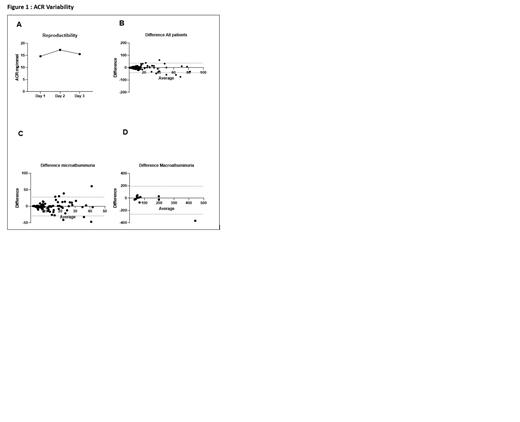Background
Patients with sickle cell disease (SCD) are at increased risk of developing renal complications, making early detection and management of these issues critical. Albuminuria has been identified as a relevant biomarker associated with chronic kidney disease (CKD) progression in SCD, as demonstrated in several studies (Gonzalez et al., 2017; Guasch et al., 2018). Quantification of albuminuria is typically performed using the urine albumin-to-creatinine ratio (ACR). However, this measurement is not without its challenges, as variability in results can occur due to several factors, including analytical method, varying sampling conditions, and biological and medical factors such as physical activity, diurnal changes, diet, and hydration, which require the collection of multiple consecutive first morning samples. Studies have shown that the use of ACR from first morning urine samples provides results comparable to the gold standard 24-hour urine collection, with improved precision and less intra-individual variability than random urine samples typically collected during clinic visits (Witte 2009, Jermendy 2001, Lambers 2008). Collecting more urine samples generally improves precision and statistical power, but Kröpelin et al (2025) showed that collecting more than three consecutive urine samples does not significantly improve precision.
Material and method
The ongoing SIKAMIC study is a phase IIb, international (France and Africa), double-blind, randomized, placebo-controlled trial. The study aims to determine the effect of hydroxycarbamide on albuminuria level after 6 months of treatment in SCD adult patients. Here, we analyzed the variability of ACR in all patients pre-selected for the study.
Microalbuminuria is commonly considered the first clinical indicator of glomerular damage in SCD. As per the KDIGO (Kidney Disease: Improving Global Outcomes), microalbuminuria is characterized by an ACR ranging from 3 to 30 mg/mmol, while macroalbuminuria refers to an ACR greater than 30 mg/mmol. For SIKAMIC study, patients with an ACR above 3 mg/mmol and below 100 mg/mmol were included.
ACR was measured in first morning urine samples over three consecutive days. Patients were instructed to collect these samples at home, which were either collected by a hospital courier or brought to the hospital/laboratory by the patient for analysis. Estimated glomerular filtration rate (eGFR) was calculated using the CKD EPI formula without ethnic criteria. Means and standard deviations of the three measurements were calculated per patient, and a reproducibility test was performed using Mixed Effect Model and Bland Altman analyses (Graphpad Prism 9).
Results
Out of the initial 179 patients pre-selected for the study (59 from France and 120 from Africa) 99 patients (34 in France and 65 in Africa) met the inclusion criteria and were enrolled in the SIKAMIC study.
Pre-selected patients from Africa were younger than patients from France with a mean age of 28.3 years and 33.8 years respectively (p<0.001). However, the mean ACR did not differ between groups (11.8 vs 12.7 mg/mmol; p=0.8) as observed for the mean eGFR value (123 vs 120.9; p=0.75). Additionally, the sex ratio was similar between groups (0.62 vs 0.67).
For all patients, the mean ACR was 14.6, 17.3 and 15.6 mg/mmol on days 1, 2 and 3, respectively, with no significant difference (p=0.43; Figure 1 : A). The mean standard deviation of ACR between day 1, 2 and 3 was 6.8 mg/mmol, suggesting good consistency and reproducibility of the ACR measurements over the three days.
Bland-Altman plots are shown in Figure 1 for the total population (n=161; 1B), microalbuminuric (1C; n=86) and macroalbuminuric (1D; n=11) patients, illustrating the agreement of ACR measurements within these subgroups.
Conclusion :
The SIKAMIC study contributes valuable insights into the evaluation of albuminuria in SCD patients. The reproducibility of the ACR appears to be sufficient to allow satisfactory monitoring on a single morning measurement in SCD routine care, both in Africa and Europe population of SCD patients.
OffLabel Disclosure:
Bartolucci:Novartis: Consultancy, Membership on an entity's Board of Directors or advisory committees; INNOVHEM: Current equity holder in private company; Addmedica: Consultancy, Membership on an entity's Board of Directors or advisory committees; Bluebird: Consultancy; Roche: Consultancy; Emmaus: Consultancy; GBT: Consultancy; Jazz Pharma: Consultancy. Cannas:Addmedica: Membership on an entity's Board of Directors or advisory committees. De Luna:GBT: Consultancy; VERTEX: Consultancy; Pfizer: Other: Principal Investigator HEMOPROVE trial. Etienne-Julan:Addmedica: Membership on an entity's Board of Directors or advisory committees. Bernit:Addmedica: Membership on an entity's Board of Directors or advisory committees. Audard:Addmedica: Consultancy; Vifor: Membership on an entity's Board of Directors or advisory committees; Astrazeneca: Membership on an entity's Board of Directors or advisory committees; Bayer: Membership on an entity's Board of Directors or advisory committees; Alnylam: Membership on an entity's Board of Directors or advisory committees.
Several observational studies conducted in adult SCD patients haveshown that hydroxycarbamide has possible protective renal effectsand may be considered as a promising therapeutic option. SIKAMICstudy evaluate the effect of 6 months treatment withhydroxycarbamide on albuminuria.


This feature is available to Subscribers Only
Sign In or Create an Account Close Modal